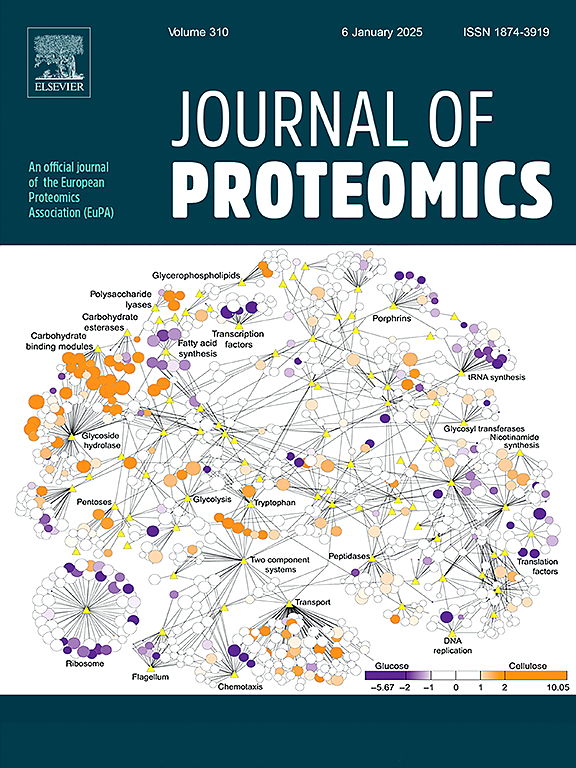比较蛋白质组学揭示了墨西哥儿科患者中枢神经系统白血病的重要分子。
IF 2.8
2区 生物学
Q2 BIOCHEMICAL RESEARCH METHODS
引用次数: 0
摘要
急性淋巴细胞白血病(ALL)是最常见的儿童血液恶性肿瘤。白血病细胞从骨髓开始扩散到其他重要器官和组织,包括中枢神经系统(CNS)。西班牙裔男性是ALL发病率最高的群体。不幸的是,关于白血病细胞浸润到中枢神经系统的分子特征信息有限,这标志着从ALL到中枢神经系统白血病(CNSL)的进展。为了解决这一知识差距,我们对ALL患者的脑脊液(CSF)与确诊CNSL患者的脑脊液进行了无标记鸟枪蛋白质组学分析。我们能够鉴定出619种蛋白质,其中包括340种以前未在CNSL受试者CSF中报道的蛋白质。与CNSL相关的主要特征包括细胞粘附蛋白如l-选择素和几种钙粘蛋白的过度积累,以及与蛋白质糖基化相关的酶的调节,这可能为白血病细胞浸润到中枢神经系统提供了适当的条件。与活性氧清除过程相关的蛋白质的过度积累揭示了缺氧和氧化还原稳态微环境条件有利于ALL向CNSL发展。关键差异蛋白的进一步鉴定将为建立可靠的CSNL分子标记奠定基础。生物学意义:中枢神经系统白血病(CNSL)是ALL的灾难性进展,由白血病细胞到达中枢神经系统而定义。以前在ALL和CNSL患者之间进行了有限的比较蛋白质组学研究。虽然这些研究是重要的开创性步骤,但难以获得与CSF相关的适量蛋白质样品阻碍了它们的发展。他们基于最少的研究对象,他们的蛋白质组学管道不包括高丰度蛋白质的消耗。定义与ALL相比,CNSL蛋白质组受到干扰的方式对于理解CNSL的分子基础以及识别和表征正确诊断的蛋白质标记物至关重要。使用分子标记提高诊断的敏感性和可靠性将有助于临床医生在发生浸润的情况下尽快实施积极的CNSL治疗,从而最大限度地提高患者的预后和生活质量,同时避免患者在尚未需要的情况下接受毒性化疗。本文章由计算机程序翻译,如有差异,请以英文原文为准。

Comparative proteomics uncovers vital molecular players of central nervous system leukemia among Mexican pediatric patients
Acute lymphoblastic leukemia (ALL) is the most common pediatric hematologic malignancy. The leukemic cells start in the bone marrow and spread to other vital organs and tissues, including the central nervous system (CNS). Hispanic males are the community with the highest incidence of ALL. Unfortunately, there is limited information on the molecular signatures of leukemic cell infiltration into the CNS, which marks the progression from ALL to central nervous system leukemia (CNSL). To address this knowledge gap, we performed a label-free shotgun proteomics between the cerebrospinal fluid (CSF) from patients with ALL compared to those with confirmed CNSL. We were able to identify 619 proteins, including 340 proteins that had not been reported prevously in the CSF of subjects with CNSL. The major features associated with CNSL included the over-accumulation of cell-adhesion proteins such as L-selectin and several cadherin proteins, along with the modulation of enzymes associated with protein glycosylation, which may provide the appropriate conditions for leukemic cell infiltration into the CNS. The over-accumulation of proteins associated with ROS scavenging processes reveals hypoxic and redox homeostasis microenvironment conditions that favors ALL progression to CNSL. The further characterization of key differential proteins will be essential for establishing reliable molecular markers for CSNL.
Biological significance
Central nervous system leukemia (CNSL) is a catastrophic progression of ALL defined by leukemic cells reaching the CNS. Limited comparative proteomics studies have been conducted previously between patients with ALL versus CNSL. While these studies were important pioneering steps, they were hindered by difficulties in obtaining the proper amount of protein samples related to CSF. They were based on minimal study subjects, and their proteomics pipelines did not include the depletion of high-abundance proteins. Defining the manners in which the CNSL proteome is perturbed compared to the ALL condition is paramount to understanding the molecular foundations of CNSL and identifying and characterizing protein markers for proper diagnosis. Improving the sensitivity and reliability of diagnosis using molecular markers would help clinicians to maximize patient outcomes and quality of life by implementing aggressive CNSL treatments as soon as possible in cases where infiltration has occurred, while avoiding exposure to toxic chemotherapies in patients where they are not yet necessary.
求助全文
通过发布文献求助,成功后即可免费获取论文全文。
去求助
来源期刊

Journal of proteomics
生物-生化研究方法
CiteScore
7.10
自引率
3.00%
发文量
227
审稿时长
73 days
期刊介绍:
Journal of Proteomics is aimed at protein scientists and analytical chemists in the field of proteomics, biomarker discovery, protein analytics, plant proteomics, microbial and animal proteomics, human studies, tissue imaging by mass spectrometry, non-conventional and non-model organism proteomics, and protein bioinformatics. The journal welcomes papers in new and upcoming areas such as metabolomics, genomics, systems biology, toxicogenomics, pharmacoproteomics.
Journal of Proteomics unifies both fundamental scientists and clinicians, and includes translational research. Suggestions for reviews, webinars and thematic issues are welcome.
 求助内容:
求助内容: 应助结果提醒方式:
应助结果提醒方式:


